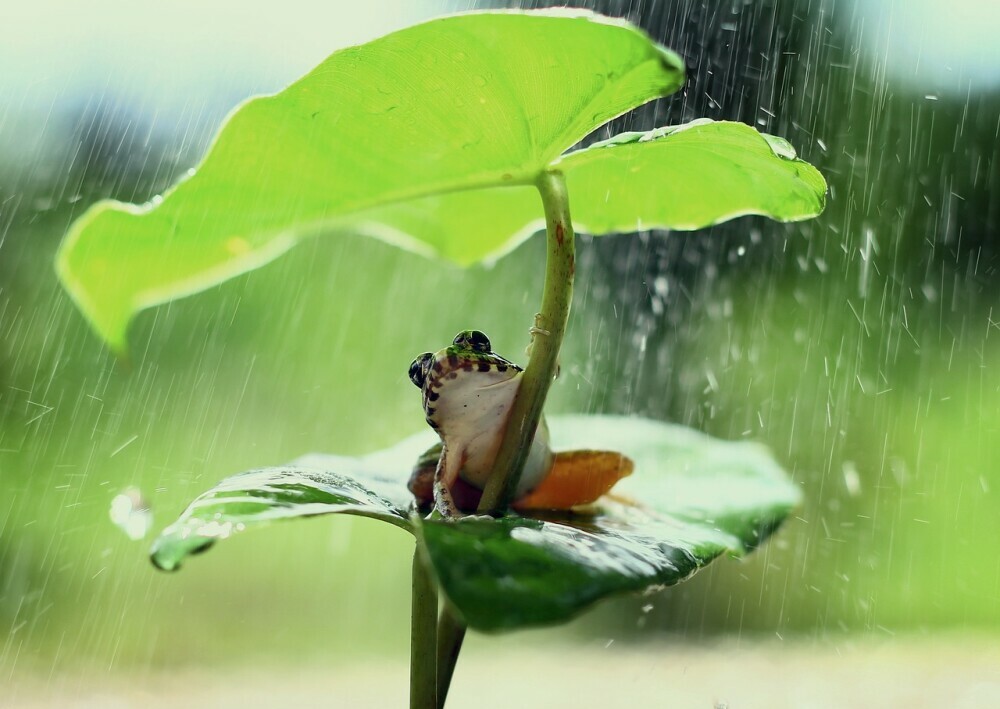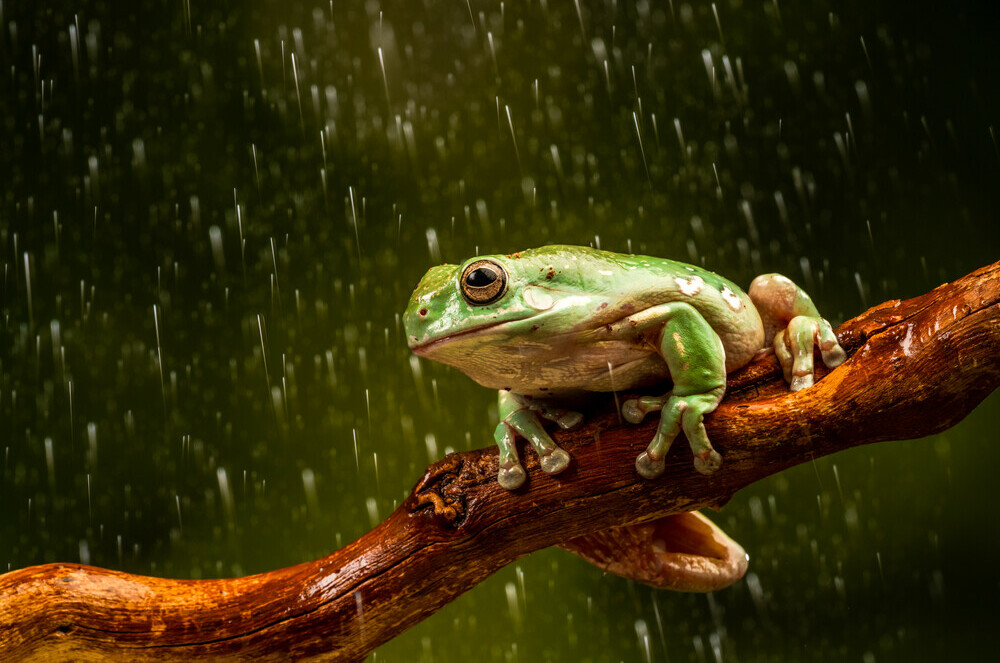When it rains, the frogs sing loudly! Did you ever wonder why some frogs are more active during rain? Are they enjoying the shower? Or is it bothering them and thus they are protesting?

These creatures are way more complex than just being green hoppers your kids might chase at the creek. They’re members of a diverse group called amphibians, which means they live dual lives – part in water, part on land. What’s really intriguing about these guys is that rain, yes, good old-fashioned rain, plays a pivotal role in their day-to-day lives.
This isn’t just about frogs liking to hop about in a downpour for fun. It’s also about survival. Frogs need moisture like we need air. It’s critical for their very existence. So when the clouds burst open, it’s as though a dinner bell is ringing for frogs everywhere. But it’s not only about getting a quick drink; there’s far more happening when the skies darken and the rain starts to fall.
If you’re curious about patterns of amphibian activity and how weather conditions play into this, you’re going to find out about how frogs are masters of utilizing their environment to their advantage, specifically when it rains. Understanding this connection is key to grasping why some frogs seem to come to life as the rain begins to pour.
Hydration’s Role: Why Rainfall is Critical for Frog Survival
You’re going to find out about why frogs cherish every droplet from the sky. It’s not just a matter of preference; it’s a matter of survival. The skin of a frog is its lifeline, performing an array of functions that keep it alive. Amphibians like frogs have a unique skin that’s permeable to water and gases, which allows them to absorb moisture and breathe through their skin, a process known as cutaneous respiration.
Consider this: without a consistent source of moisture, a frog’s skin would dry out, leading to a potentially fatal condition. That’s where rainfall plays a lifesaver role. It replenishes their skin’s essential moisture and provides a medium through which they can absorb dissolved oxygen from the environment.
Rain does more for these creatures. It also helps them to regulate their body temperature. Unlike humans, frogs are ectothermic animals, depending on external sources to manage their thermal balance. During a downpour, the cooler rainwater can offer relief from higher temperatures, helping to prevent overheating in some species.
You’re getting the picture, right? Rain is not a simple inconvenience for frogs; it is a vital element for their well-being. Let’s push on and see how the magic of rainfall not only keeps frogs primed for survival but also sets the stage for their most important life events.

Singing in the Rain: Mating Calls and Reproductive Activity During Wet Weather
You might have noticed how a rainy day brings forth a chorus of croaks and ribbits. This isn’t just about frogs enjoying a good splash; it’s also about survival. Rain plays cupid for these amphibians, setting the perfect stage for their love songs.
Rain-induced mating calls are more than just random noise. These are carefully tuned signals designed to cut through the pitter-patter of raindrops, signaling that it’s time for romance. I’m going to walk you through why these vocal gymnastics are timed with the rainfall.
One fascinating example is the explosive breeding phenomenon observed in species like the Spadefoot Toad. These critters spend most of their life underground, but when it rains, they emerge en masse to breed. It’s a race against time, and rain is the starting gun.
Transitional weather conditions, specifically the onset of rain, trigger a response in frogs to start their mating calls. For some species, males will gather at breeding sites, forming a frenzied chorus to attract females. Rainfall ensures that there are suitable aquatic environments for the eggs and tadpoles, which is why it’s synonymous with the start of the breeding season.
The inherent link between rainy spells and frog reproduction is crucial to understanding how environmental changes can affect their population dynamics. It also helps explain why you’ll hear frogs more often during and after rainfall as they take advantage of this optimal breeding period.
Feast After Famine: Increased Food Supply During Rains
Imagine this: a landscape parched under the relentless sun suddenly bursts into life as the first raindrops hit the ground. It’s not just the plants that respond; frogs, too, see this as a signal to start a period of feasting. Why? Rainfall isn’t just a source of hydration; it brings about an explosion in the availability of food for frogs.
You’re going to find out about the direct relationship between the rain and frog diets. Rain spurs the growth of plants, which in turn increases insect populations, constituting a fat-filled buffet for our amphibious friends. This is essential because many frog species have diets highly dependent on insects and other small invertebrates that thrive in moist conditions. When it rains, it’s dinner time for frogs.
That’s right, the wetter the weather, the more active these little hunters become. They don’t shy away from a feast, and rain practically sets the table for them. Frogs have different hunting strategies, and rain often boosts their most used tactic: sit-and-wait predation. With more prey available, frogs can afford to be opportunistic, snatching up whatever comes their way.
Now, transitioning to how frogs’ increased feeding during rainy weather is not just a boon for them but also vital for ecosystems. The frogs act as both predator and prey in their habitats, maintaining the delicate balance of their ecosystems. This increased activity levels during rainfall also influence their role in the food web significantly.
Keep in mind that various frog species play a significant role in controlling pest populations, thanks to their voracious appetites. They contribute to a natural form of pest control, which is beneficial for both natural ecosystems and human agricultural interests. Recognizing the value of these contributions is crucial as we ponder conservation strategies, which I’m going to talk about in the next section.

Adaptations and Survival Strategies: How Frogs Thrive in Rainy Environments
Frogs are remarkable creatures, and their ability to thrive in wet environments is a testament to their adaptability. They’ve developed a myriad of physical and behavioral adaptations that enable them to make the most of rainy conditions. For example, certain species have evolved skin that better absorbs water or have developed behaviors such as burrowing to escape the extremes.
You’re going to find out about specific frog species that are more active during rainfall and learn why their unique characteristics suit wet climates. We’re talking about frogs that have sticky pads for climbing in wet conditions, or those with a high tolerance for swimming in the increased water flow of their habitats.
Finally, let’s touch upon the conservation efforts that are crucial for protecting these amphibian habitats. Many of these rain-loving frogs are at risk due to habitat loss and climate change. Conservationists are working to preserve the environments that are essential for these species to continue their rain-centric life cycles. By understanding the importance of rainy environments to these frogs, we can better appreciate the intricate balance of ecosystems and the need for their preservation.
I really hope that you’ve gained new insights into why some frogs are more active during rain and a greater appreciation for these fascinating creatures. Protecting their habitats not only ensures their survival but also maintains the biodiversity that enriches our planet.
